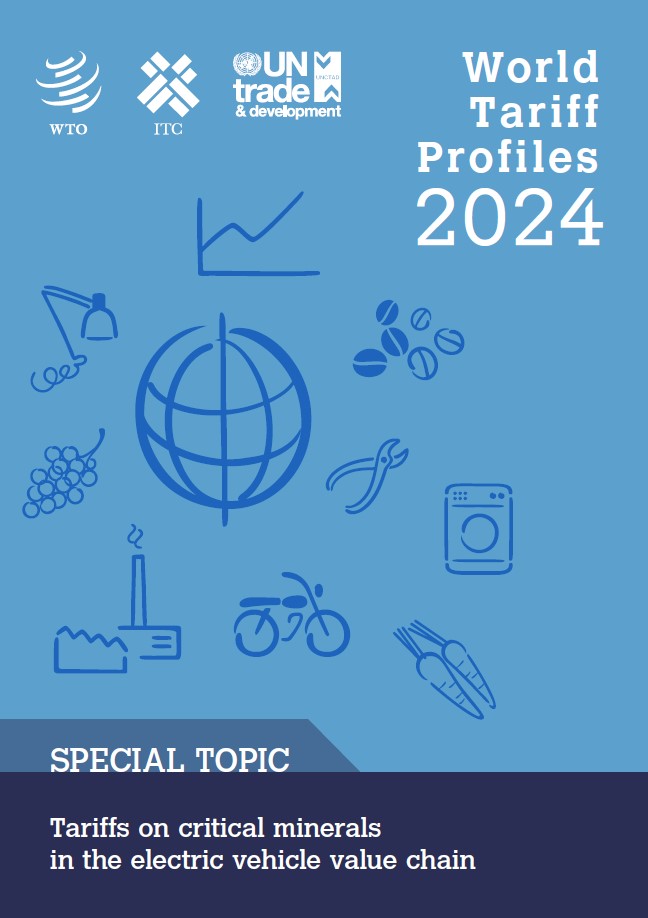- home
- trade topics
- tariffs
- get tariff data
TARIFFS
Get tariff data
The WTO website offers sophisticated options for researching members' customs duty rates and their levels of exports/imports. The new WTO Tariff & Trade Data platform provides enhanced access to official tariff and trade figures for over 150 economies. It includes bilateral trade datasets, time series views, and reports on export and import patterns by product and trade partner. It improves on the previous Tariff Analysis Online.
Through the WTO Tariff & Trade Data platform, users can obtain and compare two sets of customs tariffs:
-
the legally bound commitments on customs duty rates, which act as ceilings on the tariffs that member governments can set and are known as "bound rates", with
-
the rates that governments actually charge on imports, which can be lower, are known as "applied rates" and have a direct impact on trade.
The platform aggregates official information about applied tariffs and import data notified by WTO members to the WTO's Integrated Data Base (IDB), and bound duties (agreed maximum tariffs) and other commitments recorded in the WTO's Consolidated Tariff Schedules (CTS) database. This data is supplemented by the WTO Analytical Database (ADB), which integrates WTO sources such as regional trade agreements (RTA) and external partners such as the International Trade Centre, UN Comtrade and Trade Data Monitor.
The platform follows a multi-tiered update schedule, with updates ranging from daily to monthly, depending on the data source.
The Integrated Database (IDB) contains time series of the tariffs applied by WTO members and acceding economies to imports from other WTO members. Data are provided at the most detailed product level (usually the eight to ten digit product level or tariff line code). The database also contains import statistics, including the value and volume of imports by country of origin and by tariff line. This internal database cannot be accessed outside of the WTO. Find out more.
The Consolidated Tariff Schedules (CTS) Database contains the agreed maximum tariffs that WTO members can impose on imported products from other WTO members. This internal database cannot be accessed outside of the WTO. Find out more.
WTO Data Portal (WTODATA) contains general statistical indicators of international trade, including bound and MFN applied tariffs.
Customs codes and standardization
Products in the databases are identified using the World Customs Organization's internationally agreed "Harmonized System" (HS).
Under the system, the broadest categories of products are identified by two-digit "chapters" (e.g. 04 is dairy products, eggs and other edible animal products). These are then sub-divided by adding more digits: the higher the number of digits, the more detailed the categories. For example, the four-digit code or "heading" 0403 is a group of products derived from milk. At six digits, 0403.10 is the "sub-heading" for yoghurt; at the eight-digit level, 0403.10.11 could be low-fat yoghurt "tariff line".
The codes are standard up to six digits, the most detailed level that can be compared internationally. Beyond that, WTO members are free to use their own definitions according to their individual requirements.
For each member
Data in simpler forms are also available through each member's page on the WTO website (see, for example, Argentina). These pages can be reached from the list of members.
The original lists of members' bound commitments remain available. The digit-level of the bound duty rates in these "schedules of commitments" can vary from member to member.
Research: Special topics in World Tariff Profiles
Each edition of the World Tariff Profiles contains at least one special topic:
- 2024: Tariffs on critical minerals in the electric vehicle value chain
- 2023: 1) The evolution of market access over 16 years of "World Tariff Profiles" and 2) Product classification for WTO trade statistics and policy analysis ?Multilateral Trade Negotiations (MTN) Categories
- 2022: 1) Preferential rules of origin in international trade and 2) Non-tariff measures on "green" and "brown" energy products
- 2021: Non-tariff measures: Estimating analytical indicators using UNCTAD's Trade Analysis Information System (TRAINS)
- 2020: Market access for medical goods and COVID-19 medical supplies
- 2019: Aligning trade and tariff policies with sustainable development
- 2018: Utilization of preferential tariff treatment for products exported by least developed countries
- 2017: Export diversification
- 2016: 2017 version of the Harmonized System
- 2015: Tariff accumulation, effective protection and export competitiveness in global production
- 2014: Anti-dumping
- 2013: Regional Trade Agreements
- 2012: Latest notifications on the implementation of scheduled commitments under the Agreement on Agriculture
- 2011: Schedule of concessions: other duties and charges
- 2010: Schedule of concessions: other duties and charges
- 2009: Schedule of concessions: other duties and charges
- 2008: The Harmonized System ?amendments and their impact on WTO members' schedules
- 2006: Tariff aggregation methods ?what are the implications
Share
- ad valorem (AV): a tariff rate charged as percentage of the price
- applied rates: duties that are actually charged on imports. These can be below the bound rates
- bound rates (tariff binding): commitment not to increase a rate of duty beyond an agreed level. Once a rate of duty is bound, it may not be raised without compensating the affected parties
- digits, digit-level: (tariffs) a reference to the codes used to identify products. Categories of products are subdivided by adding digits. See Harmonized System
- Harmonized System: World Customs Organization’s system of code numbers for identifying products. The codes are standard up to six digits. Beyond that countries can introduce national distinctions for tariffs and many other purposes
- MFN (most-favoured-nation) tariff: normal non-discriminatory tariff charged on imports (excludes preferential tariffs under free trade agreements and other schemes or tariffs charged inside quotas)
- schedules: (for goods) list of bound tariff rates
- tariff line (TL in the tables): a product, as defined by a system of code numbers for tariffs
- More jargon: glossary
